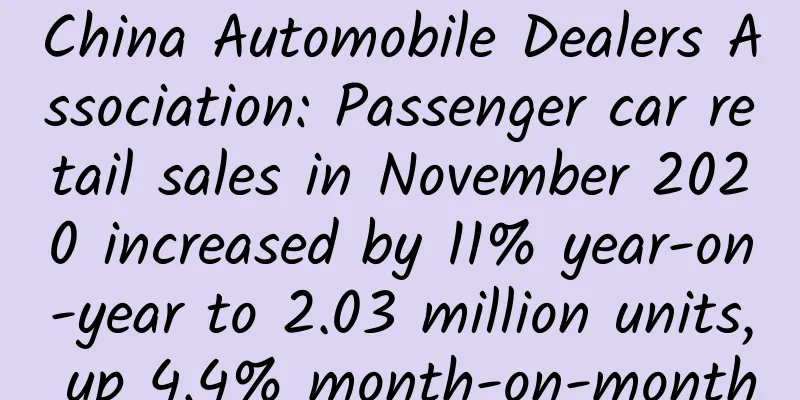|
In November, passenger car retail sales increased by 11% year-on-year to 2.03 million units, and increased by 4.4% month-on-month; new energy vehicle sales reached 179,000 units, a year-on-year increase of 157%; luxury car sales reached 340,000 units, a year-on-year increase of 26.7%, with 72,000 new cars added, and a month-on-month increase of 13.2%, with 40,000 new cars added; luxury car sales accounted for 16.7% of the overall passenger car market sales, an increase of 1.2 percentage points from the previous month. From January to November, the cumulative sales of passenger cars reached 17.26 million, down 9.8% year-on-year and 1.88 million fewer than last year; the cumulative sales of new energy vehicles reached 910,000, up 27% year-on-year; the cumulative sales of luxury cars reached 3.03 million, up 9.3% year-on-year and 257,000 more than last year. • Sales volume of passenger cars, luxury cars and new energy vehicles (unit: 10,000 units) BMW tops sales in November Model 3 becomes the best-selling single model In November, BMW sold 74,000 vehicles, up 15.4% year-on-year, Mercedes-Benz sold 72,000 vehicles, up 22.4% year-on-year, and Audi sold 71,000 vehicles, up 10.6% year-on-year. At the end of the year, market consumer demand was further released, and the sales of second-tier luxury brands increased rapidly. Lexus sold 25,000 vehicles, up 40% year-on-year; Cadillac sold 25,000 vehicles, up 70% year-on-year; Lincoln increased by 78% to 7,300 vehicles, up 5.3% month-on-month. In November, Model 3 surpassed many luxury brand models for the first time with sales of 22,000 units, ranking first in sales; Audi A6L ranked second with sales of 17,600 units; BMW 3 Series, 5 Series, and Mercedes-Benz GLC all sold more than 16,000 units; Audi A4L and Audi Q5L both sold more than 15,000 units. • Top 10 brands and models sold in November (unit: 10,000 units) SUV market segment maintained rapid growth in November In November, luxury sedan sales accounted for 53% of the total sales, up 25% year-on-year, while luxury SUV sales accounted for 46%, up 27% year-on-year. In terms of market segments, mid-size sedan sales reached 93,000 units, up 62% year-on-year and 20% month-on-month, with an increase of 16,000 units compared to October, mainly due to Model 3, Audi A4L up 19%, and BMW 3 Series up 51%; mid-size SUV market sales reached 80,000 new cars, up 13% year-on-year and 11% month-on-month, mainly due to models of Mercedes-Benz, BMW, Audi and Lexus; mid-to-large sedan market sales reached 58,000 units, up 4.8% year-on-year and 18% month-on-month, mainly due to the accelerated growth driven by the facelifted BMW 5 Series and Mercedes-Benz E-Class; compact SUV market grew 54% year-on-year to 40,000 units, with sales growth coming from new cars GLB, GLA, Lincoln Aviator, XT4 and Volvo XC40; mid-to-large SUV market grew 44% to 18,000 units, with growth coming from BMW X5, Mercedes-Benz GLE, Cayenne, Cadillac XT6 and Lincoln Aviator. • Market share and sales volume in November compared to the same period last year In November, luxury cars sold 150,000 new cars in East China, a year-on-year increase of 31% and a month-on-month increase of 14%. Among them, Tesla sold 11,700 vehicles, a year-on-year increase of 406%. The policy adjustment in Shanghai stimulated the growth of electric vehicle sales; Cadillac increased by 85% year-on-year to 5,055 vehicles; the sales of the two highest-selling brands, Mercedes-Benz and BMW, both maintained sales of more than 30,000 in East China, an increase of more than 20%. Sales in South China increased by 24% year-on-year to 50,000 vehicles. Mercedes-Benz increased by 24% to 10,000 vehicles in South China, while BMW only increased by 10% to 11,000 vehicles. Lexus increased by 46% to 7,000 vehicles in South China, and Audi increased by 4.6% to 7,900 vehicles. • Luxury car sales by region in November (unit: 10,000 units) In November, from the perspective of provincial sales, Shanghai's sales increased by 62% year-on-year to 24,000 vehicles, of which new energy vehicle sales increased by 435% year-on-year to 8,100 vehicles, and increased by 188% month-on-month. Several provinces with large increases in November were all related to traffic restrictions, new online car-hailing licenses, incentives for car purchases, and new licenses. Hainan's sales increased by 51%, Tianjin by 33%, Shandong by 32%, and Hebei by 26%. Traffic restrictions and license plate quotas in November Sales of new energy vehicles surged in some provinces and cities In November, Beijing introduced measures to control the problem of "one person with multiple license plates". Car owners with multiple license plates began to sell their old cars and buy new ones, which drove up sales in Beijing's auto retail market at the end of the year. In November, Beijing sold 62,000 new cars, a year-on-year increase of 18%, of which 18,000 were luxury cars, a year-on-year increase of 20% and a month-on-month increase of 14%. Shanghai will restrict the entry of out-of-town cars next year, which has led to a significant increase in sales of electric vehicles that do not require a lottery and can be connected to charging piles. In November, Shanghai sold 8,100 electric vehicles, a year-on-year increase of 435% and a month-on-month increase of 189%. In November, passenger car sales in Hebei and Henan increased by 14%, and Shandong increased by 17%. As the winter heating season began, provinces such as Hebei, Henan and Shandong were under great pressure to protect the environment and began to impose traffic restrictions on motor vehicles. Henan and Hebei adopted odd-even number restrictions and license plate number restrictions, and Jinan, Shandong restricted the passage of vehicles from other places. These measures greatly stimulated local consumers to buy cars. Some car owners chose low-priced electric cars when buying their second car, which led to a significant increase in the sales of pure electric new energy vehicles in these three regions. In November, Henan sold 14,000 pure electric vehicles, a year-on-year increase of 268%, Shandong sold 12,000 vehicles, a year-on-year increase of 237%, and Hebei sold 6,000 vehicles, a year-on-year increase of 298%. Jiangsu promoted the sales of pure electric vehicles through measures such as electric vehicles going to the countryside, with sales of 9,000 vehicles in November, a year-on-year increase of 168%. Among the newly added pure electric models, Wuling Hongguang EV mini with a guide price of 28,800 yuan accounted for a large proportion. In November, Hongguang EV mini sold 31,000 units nationwide, 6,300 units in Henan, 5,050 units in Shandong, 2,900 units in Jiangsu, and 2,500 units in Hebei; Great Wall Ora Black Cat became the second best-selling low-priced electric car, with 8,100 units sold nationwide, a guide price of 69,800 yuan, and a price of more than 50,000 yuan. In November, 2,000 units were sold in Henan, 1,000 units in Shandong, and 840 units in Hebei. Traffic restrictions and other measures will alleviate the improvement of air quality to a certain extent, but at the same time they will stimulate consumers to purchase more vehicles, which will in turn aggravate parking tension and road congestion. • November luxury car sales by province and city and year-on-year growth (unit: 10,000 units) In November, due to the increase in online car-hailing quotas and the impact of the "oil-to-electric" conversion of online car-hailing, the sales of pure electric vehicles in some provinces and cities increased significantly; Shenzhen's online car-hailing will be "oil-to-electric" by the end of the year, and 7,600 pure electric models were sold in November, a year-on-year increase of 183%; Tianjin released a batch of online car-hailing quotas, driving the sales of pure electric models to 5,500, a year-on-year increase of 201%, among which the online car-hailing sales were relatively large, including 999 Hongqi E-HS3, more than 300 GAC New Energy, and nearly 140 Beijing brand. The "oil-to-electric" conversion of taxis in various parts of Shanxi also drove the sales of pure electric models. In November, Shanxi sold nearly 5,400 pure electric models, a year-on-year increase of 192%, of which 2,100 were for rental or online car-hailing purposes. In November, Hainan had the greatest stimulus to the automobile market, with pure electric models enjoying a maximum subsidy of 10,000 yuan, plus a 3,000 yuan subsidy in some cities, and a new batch of fuel vehicle quotas were added. In November, Hainan sold 19,000 new cars, a year-on-year increase of 109%, of which 5,200 were pure electric and plug-in models, a year-on-year increase of 290%, and more than 2,800 were online car-hailing vehicles, a year-on-year increase of more than 500%. The most popular sales were nearly 1,300 WM EX5s, accounting for nearly 50% of WM's total sales in November, more than 500 GAC Aion Ss, more than 110 Corolla Hybrid E+s, and more than 120 BYD Qin EVs. In November, the sales of pure electric and plug-in hybrid models of mid-to-high-end and luxury brands represented by Tesla totaled 24,000 units, a year-on-year increase of 200%. Among them, Model 3 sold 21,600 units, a year-on-year increase of 363%, Ideal One sold 4,676 units, Xiaopeng P7 sold 2,713 units, Weilai ES6 sold 2,375 units, Audi e-tron sold 836 units, Audi Q2 e-tron sold 453 units, and Mercedes-Benz EQC sold 727 units. Luxury brand pure electric models all had good growth in November. In November, the sales of new energy vehicles were divided into three types according to price. Entry-level electric vehicles represented by Wuling Hongguang EV mini and Great Wall Euler Black Cat were quickly recognized by consumers. In some provinces with large populations, with the help of existing distribution channels, the sales growth rate was relatively fast. Electric vehicles priced at more than 100,000 yuan, represented by GAC New Energy, Beijing Brand, Weimar, and Hongqi New Energy, were mainly sold in the online car-hailing and rental markets due to the limited sales channels. However, this part of the market fluctuated greatly. Generally, sales were good this month, but sales were likely to drop sharply next month. High-end electric vehicles represented by Tesla were mainly sold in cities with purchase and traffic restrictions and first- and second-tier central cities. They were priced higher and sales grew steadily. Among these three types, if they mainly rely on the online car-hailing and rental markets and survive on subsidies, their prospects are the most uncertain. Entry-level electric vehicles are the most distinctive products in the electric vehicle field this year, and they also reflect the manufacturing and supply chain advantages of independent brands. The rapidly expanding sales have also accumulated a large number of new energy points. Under the premise of this year's point price increase, there will be a certain income through sales points. Cumulative sales of passenger cars from January to November decreased by 1.88 million units compared with last year Domestic brands saw the largest sales decline From January to November, passenger car dealers sold a total of 17.26 million new cars, down 9.8% year-on-year and 1.88 million fewer than last year; the market share of domestic brands was 33%, down 1 percentage point from the same period last year, German brands were at 27%, the same as last year, Japanese brands were at 25%, up 2 percentage points from the same period last year, American brands were at 9%, the same as last year, Korean brands were at 4%, down 1 percentage point from the same period last year, and French brands' market share fell from 1 percentage point last year to zero. The market share of European brands represented by Volvo, Jaguar Land Rover and other brands increased by 1 percentage point to 2 percentage points. • Cumulative market share and year-on-year growth of brands from January to November From the perspective of brand categories, domestic brands sold 5.67 million vehicles, down 14% year-on-year to 910,000 vehicles, with the largest sales decline; from the perspective of segment levels, small SUV market sales fell by 380,000 vehicles, compact car sales fell by 280,000 vehicles, compact MPV sales fell by 180,000 vehicles, compact SUV sales fell by 46,000 vehicles, and microvan sales fell by 160,000 vehicles. Domestic brands with relatively large declines include: Baojun brand fell by 220,000 vehicles, Geely brand fell by 170,000 vehicles, Trumpchi brand fell by 110,000 vehicles, SAIC Group's Roewe and MG fell by 130,000 vehicles, FAW brand fell by 100,000 vehicles (FAW brand mainly refers to the Senya series of models produced by FAW Jilin, which has only sold 540 vehicles this year), and Beijing brand fell by 80,000 vehicles. The 1 percentage point of domestic brand sales lost was replaced by Japanese brands. Japanese brands released many new cars in the compact class last year, which put pressure on domestic brand sales. Japanese brands saw the smallest decline in November In the first 11 months, the market share of Japanese brands increased by 2 percentage points, with cumulative sales of 4.34 million vehicles, a year-on-year decline of 2.6%. Against the backdrop of the decline in the domestic passenger car market, Japanese brands had the smallest decline among all brands. From the analysis of market segments, Japanese brands have expanded their share in the compact market, with compact SUV sales increasing by 3.5% to 930,000 units, an increase of 32,000 units over the same period, and compact sedan sales of 1.52 million units, a year-on-year increase of 0.5%. The market share of domestic brands and Japanese brands in the compact market is a relationship of increase and decrease. While expanding sales in the compact market, Japanese brands have also achieved growth in the mid-size SUV and mid-size sedan segments, with a 5.3% increase in the mid-size SUV market to 380,000 units, and a 5.3% increase in the mid-size sedan market to 730,000 units. Japanese brands have expanded sales through compact models and increased profits through the mid-size market. In November, the market share of German and American brands remained the same In the first 11 months, the market share of German and American brands was the same as the same period last year. Among German brands, luxury car sales accounted for a certain proportion, which led to an increase in the overall sales of German brands. Among American brands, Tesla and Lincoln maintained a large increase. Buick's abandonment of the three-cylinder engine brought it a turnaround. In the first 11 months, it sold 740,000 vehicles, the same as last year's sales, stopping the decline. Chevrolet, Jeep, and Ford's sales fell significantly. After a year of adjustment, there was not much improvement. In November, Mercedes-Benz sold 72,000 new cars, up 15.4% year-on-year and 19.6% month-on-month. From January to November, the cumulative sales reached 711,000, up 68.3% year-on-year. Among them, the cumulative sales of domestic models reached 572,000, up 8% year-on-year, and the cumulative sales of imported models reached 138,000, up 12% year-on-year. The average selling price of Mercedes-Benz brand in November was 452,000 yuan, up 17,000 yuan from the previous month; the brand discount rate in November was 7.9%, down 0.6% from October, and the profit of Mercedes-Benz dealers in November was further improved. • November sales overview of Mercedes-Benz's main models (unit: 10,000 units) In November, the Mercedes-Benz GLC sold 15,000 units, a year-on-year increase of 14%. The mid-term facelifted E-Class sold 13,000 units in November, a year-on-year increase of 23% and a month-on-month increase of 14%. The average transaction price was 499,000 yuan, and the discount level was about 6 percentage points. The facelifted E-Class was recognized by consumers and the new car sales had good profits. In November, Mercedes-Benz GLB sold 5,680 units, GLA sold 2,830 units, and A-Class sold 5,590 units. The sales of these three compact models were relatively stable, which was of great help in adjusting the sales structure of domestic models. Among imported models, the sales of Mercedes-Benz S-Class exceeded 3,000 units, a year-on-year increase of 15%, and the sales of GLE increased by 41%, an increase of 84%. In November, Guangdong was the province with the highest sales of Mercedes-Benz, with a year-on-year increase of 24% to 9,000 units. Jiangsu and Zhejiang followed closely behind, with sales of more than 8,000 units each, a year-on-year increase of more than 20%; Hainan's sales increased by 72% due to the increase in fuel vehicle license plates; other provinces with sales growth of around 30% include Gansu, Tibet, Jilin, Guizhou, Jiangxi, Shaanxi and other places. In November, BMW sold 74,000 new cars, a year-on-year increase of 15.4% and a month-on-month increase of 19.4%, ranking first in monthly sales of luxury cars; cumulative sales from January to November reached 689,000 units, a year-on-year increase of 8.5%, of which domestic models sold a total of 549,000 units, a year-on-year increase of 14%, and imported models sold a total of 139,000 units, a year-on-year decrease of 8%. • November sales overview of BMW's main models (unit: 10,000 units) In November, BMW's sales quality was further improved, and dealers' retail profits improved significantly. Some dealers' new car profits were more than 5 percentage points. November was the second full sales month for the BMW 5 Series after the mid-term facelift, with a total sales of 12,000 units, a month-on-month increase of 53%, and an average transaction price of 442,000 yuan. If the plug-in version and imported 5 Series are included, sales have exceeded 16,000 units, with new car discounts of about 8 percentage points, and pre-facelift 5 Series discounts of about 12 percentage points. As the 5 Series accounts for a large proportion of sales revenue, the recovery of discounts has greatly helped dealers' new car profits. The dominant position of the BMW 3 Series was further consolidated, with sales of 15,000 units in November, a month-on-month increase of 15%, and sales discounts controlled at around 10%; another model with sales of over 10,000 was the X3, with sales of 13,000 units in November, a month-on-month increase of 5%; imported models X5 sold 5,500 units, a month-on-month increase of 30%, and X7 sold 1,100 units, a month-on-month increase of 26%. In November, Zhejiang was the province with the highest BMW sales, with a year-on-year increase of 13% to 10,000 vehicles. Tianjin's sales increased by 54%, Jiangsu's sales increased by 32% to 8,500 vehicles, and sales in Shandong, Fujian, Shaanxi, Jiangxi and other provinces all increased by more than 20%. In November, Audi sold 71,000 new cars, up 10.6% year-on-year and 4.7% month-on-month; from January to November, the cumulative sales were 653,000, up 7% year-on-year, of which the cumulative sales of domestic models were 604,000, up 9% year-on-year, and the cumulative sales of imported models were 48,000, down 11% year-on-year. The brand discount rate in November was 21.4%, the same as in October. • November sales overview of Audi's main car series (unit: 10,000 units) In November, Audi A4L sold 16,000 units, up 19% year-on-year, A6L sold 16,000 units, A6L e-tron sold 1,020 units, and Q5L sold 15,000 units, up 9% year-on-year. In the compact market, Audi's compact portfolio sold 5,100 units of Q3, 4,500 units of Q2L, and 5,400 units of A3. Audi's compact and small car sales are stable at around 15,000 units, so Audi's monthly sales are basically around 60,000 units. Audi needs to further increase the sales of imported models to increase dealers' sales profits. In November, Jiangsu was the province with the highest sales volume for Audi, with a year-on-year increase of 23% to 9,000 vehicles. Hainan's sales increased by 82%, and sales in Sichuan, Xinjiang, Qinghai and other provinces increased by more than 30%; sales in Chongqing, Guizhou and other provinces increased by more than 20%. In November, Cadillac sold 25,000 new cars, a year-on-year increase of 71%; from January to November, the cumulative sales volume was 195,000, a year-on-year increase of 1.2%. In November, the discount rate of the Cadillac brand was 21.7%, the same as in October. In November, Lexus sold 25,000 new vehicles, a year-on-year increase of 40% and a month-on-month increase of 19.3%; cumulative sales from January to November reached 208,000 vehicles, a year-on-year increase of 16.9%. In November, Volvo sold 17,000 new cars, a year-on-year increase of 23.2%; from January to November, the cumulative sales volume was 149,000, a year-on-year increase of 8%. In November, the discount rate of Volvo brand was 23%. In November, Porsche sold 7,800 new cars, a year-on-year increase of 1.5%; cumulative sales from January to November were 78,000 vehicles, a year-on-year decrease of 1.6%. In November, Jaguar sold 2,600 new cars, a year-on-year increase of 81%; Land Rover sold 8,400 new cars, a year-on-year increase of 22.4%; from January to November, Jaguar sold a total of 22,000 vehicles, and Land Rover sold a total of 62,000 vehicles. In November, Lincoln sold 7,300 new cars, a year-on-year increase of 78%; from January to November, the cumulative sales volume reached 54,000, a year-on-year increase of 23%. In November, the discount rate of the Lincoln brand was 7.3%. In November, Infiniti sold 2,580 new cars, down 31% year-on-year; cumulative sales from January to November were 25,000 vehicles, down 34% year-on-year. In November, Acura sold 930 new cars, a year-on-year decrease of 35%; cumulative sales from January to November were 10,000 vehicles, a year-on-year decrease of 24%. In November, Maserati sold 430 vehicles, down 7% year-on-year; cumulative sales from January to November were 4,100 vehicles, down 38% year-on-year. In November, 22,000 vehicles were sold; cumulative sales from January to November reached 123,000 vehicles, a year-on-year increase of 215%. |










